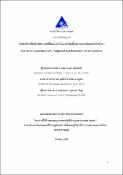บทคัดย่อ
เนื้องอกสมองชนิดแอสโตไซโตมา (Astrocytoma) สามารถพบการเปลี่ยนแปลงเป็นมะเร็ง (Malignant transformation: MT) พบได้ร้อยละ 9-23 ซึ่งการเกิดการเปลี่ยนแปลงดังกล่าวส่งผลต่อการพยากรณ์โรคของผู้ป่วยแย่ลง และในปัจจุบันยังขาดหลักฐานเชิงประจักษ์ในเรื่องของปัจจัยที่สัมพันธ์ต่อการเกิด malignant transformation ดังนั้นการศึกษานี้มีวัตถุประสงค์ 1. ทราบถึงปัจจัยที่สัมพันธ์กับการเปลี่ยนแปลงเป็นมะเร็งของเนื้องอกสมองชนิดแอสโตไซโตมา 2. ทราบถึงการพยากรณ์โรคเนื้องอกสมองชนิดแอสโตไซโตมาตามลักษณะของดัชนีทางชีวภาพ ระเบียบวิธีวิจัย ศึกษาย้อนหลังแบบ Retrospective cohort ในผู้ป่วยเนื้องอกสมองแอสโตไซโตมา ชนิด low-grade astrocytoma ที่เข้ารับการรักษาภายในโรงพยาบาล ขั้นตอนการดำเนินงานวิจัยสามารถแบ่งได้เป็น 4 ขั้นตอน ได้แก่ 1. การตรวจหา candidate gene ในชิ้นเนื้อ fresh frozen 2. การตรวจหาการกลายพันธุ์ของ candidate gene จากชิ้นเนื้อ formalin-fixed paraffin-embedded และ fresh frozen tissue 3. การวิเคราะห์หาปัจจัยที่สัมพันธ์กับการกลายเป็นมะเร็ง และ 4. การพัฒนาสร้างโนโมแกรม ผลการศึกษา การตรวจหา candidate gene จากการตรวจ whole genome sequencing สมมติฐานว่าการกลายพันธุ์ของยีน IDH น่าจะมีส่วนเกี่ยวข้องกับกระบวนการ MT จากนั้นจึงทำการตรวจหาการกลายพันธุ์ของ IDH 1 และ IDH 2 จากผู้ป่วย จำนวน 90 ราย พบการกลายพันธุ์ของ IDH 1 พบได้ร้อยละ 12.2 และเป็นการกลายพันธุ์แบบ R132H ทั้งหมด ขณะที่ร้อยละ 10 พบการกลายพันธุ์ของ IDH 2 โดยเป็นการกลายพันธุ์แบบ R172K ทั้งหมด จากนั้นทำการวิเคราะห์ Survival analysis พบว่า การเกิด MT สัมพันธ์กับพยากรณ์ระยะเวลารอดชีพที่สั้นอย่างมีนัยสำคัญทางสถิติ (log-rank test, p=0.006) และผลการวิเคราะห์หาปัจจัยที่สัมพันธ์กับการเกิด MT โดยวิธี multivariable analysis พบว่า ปัจจัยที่เกี่ยวข้องประกอบด้วย midline shift of more than 1 cm, extent of resection และ IDH 1 mutation จากนั้นทำการสร้างโนโมแกรมสำหรับทำนายโอกาสการเกิด MT พบว่า โนโมแกรมมีความสามารถในการทำนายในระดับ excellent สรุป การเกิด MT ส่งผลต่อพยากรณ์โรคในผู้ป่วยเนื้องอกสมองชนิดแอสโตไซโตมาโดยตรง ดังนั้น มาตราการเฝ้าระวังอย่างใกล้ชิดในผู้ป่วยที่มีปัจจัยเสี่ยงจึงมีความสำคัญในการติดตามการรักษา
บทคัดย่อ
Astrocytoma can be found to develop malignancy in 9-23 percent that is significantly associated with poor prognosis. From a literature review, lack of evidence mentioned about risk factors associated with malignant transformation. The study objectives were 1. to identify factors associated with malignant transformation 2. To identify the prognosis of astrocytoma that developed malignant transformation according to biomarkers. Method The present study was a retrospective cohort study and the study population was patients who were diagnosed with low-grade astrocytoma. The processes of the study comprised 4 processes as follows: 1. investigation of the candidate genes from fresh frozen tissue 2. Investigation of candidate gene mutations 3. survival analysis 4. nomogram development. Results Following whole-genome sequencing, IDH 1 and IDH 2 mutations were candidate genes. In 90 patients, IDH 1 and IDH 2 mutations were found in 12.2% and 10%, respectively. Malignant transformation was associated with a short survival time (log-rank test, p=0.006). Factors associated with malignant transformation were a supratentorial tumor, midline shift of more than 1 cm, the extent of resection, and IDH 1 mutations following multivariable analysis. Therefore, a nomogram was developed for predicting malignant transformation. Conclusion Malignant transformation was significantly associated with poor prognosis; therefore, a close follow-up strategy should be applied in high-risk patients.


